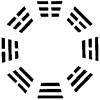
The eight diagrams symbolize the eight natural phenomena: sky, earth, thunder, wind, water, fire, mountain and lake.
Through combinations of three broken or unbroken horizontal lines they could be made to symbolize aspects of the universe. Their earliest use as decoration on ceramics dates from the late Song period.These eight sets of three straight lines are often arranged in a circle. They are said to have been evolved from the markings on the shell of a tortoise by the legendary sage Emperor Fuxi.
The unbroken lines represent the male principle Yang and the broken lines represent the Female principle Ying.
The arrangement in a circle is important as this is referring to the cyclic changes of the nature and is fundamental for the understanding of Chinese philosphy from its earliest beginning.
The founder of the Zhou dynasty (11th century (1027) to 221 B.C.)- is said to have been the one who first appended to each of them certain explantions. This work was continued by his son, and this is what is described in the "Book of Changes", the most venerated and least understood of all Chinese classics.
When properly studied these diagrams will tell you the secrets of divination, geomancy, the elements of metaphysical knowledge and the clue to the secret of creation.
The two spheres refer to heaven and earth, or yin (feminine, negative) and yang (masculine, positive).
The four elements are metal, wood, water and fire, which are everywhere.
The eight diagrams symbolize the eight natural phenomena: sky, earth, thunder, wind, water, fire, mountain and lake. So the picture represented the ancient Chinese's earliest knowledge of the universe, which contained a simple dialectical materialist point of view .
What is more interesting is the picture of the Eight Diagrams, which are formed of yao (lines), namely, the yangyao (male line, whole line written as __) and the yinyao (female line, a broken line written as - -. )
The two forms are contradictory opposites and they form the eight combinations.
By taking two of them or doubling them, 64 combinations can be made.
It has been suggested that the German mathematician Wilhelm von Leibuiz (1646-1716) was inspired by the Chinese Eight Diagrams to create the binary system. If this was true, then the Chinese picture of the Ultimate and the Eight Diagrams made some historic contribution to the modern computer science.
In the early 1930's the Chinese scholar Liu Zihua, 27 years of age who was in France on a work-study basis, used the Eight Diagrams, without recourse to Newton's theory of gravity, to forecast the existence of the tenth planet of the solar system, and wrote a thesis entitled "The Eight Diagrams Theory of the Universe and Modern Astronomy", which won him the French national doctorate in 1938 and thrilled the world astronomy profession.
The Chinese picture of the Ultimate and the Eight Diagrams is still being studied by some Western scholars as a source of ancient science.
A